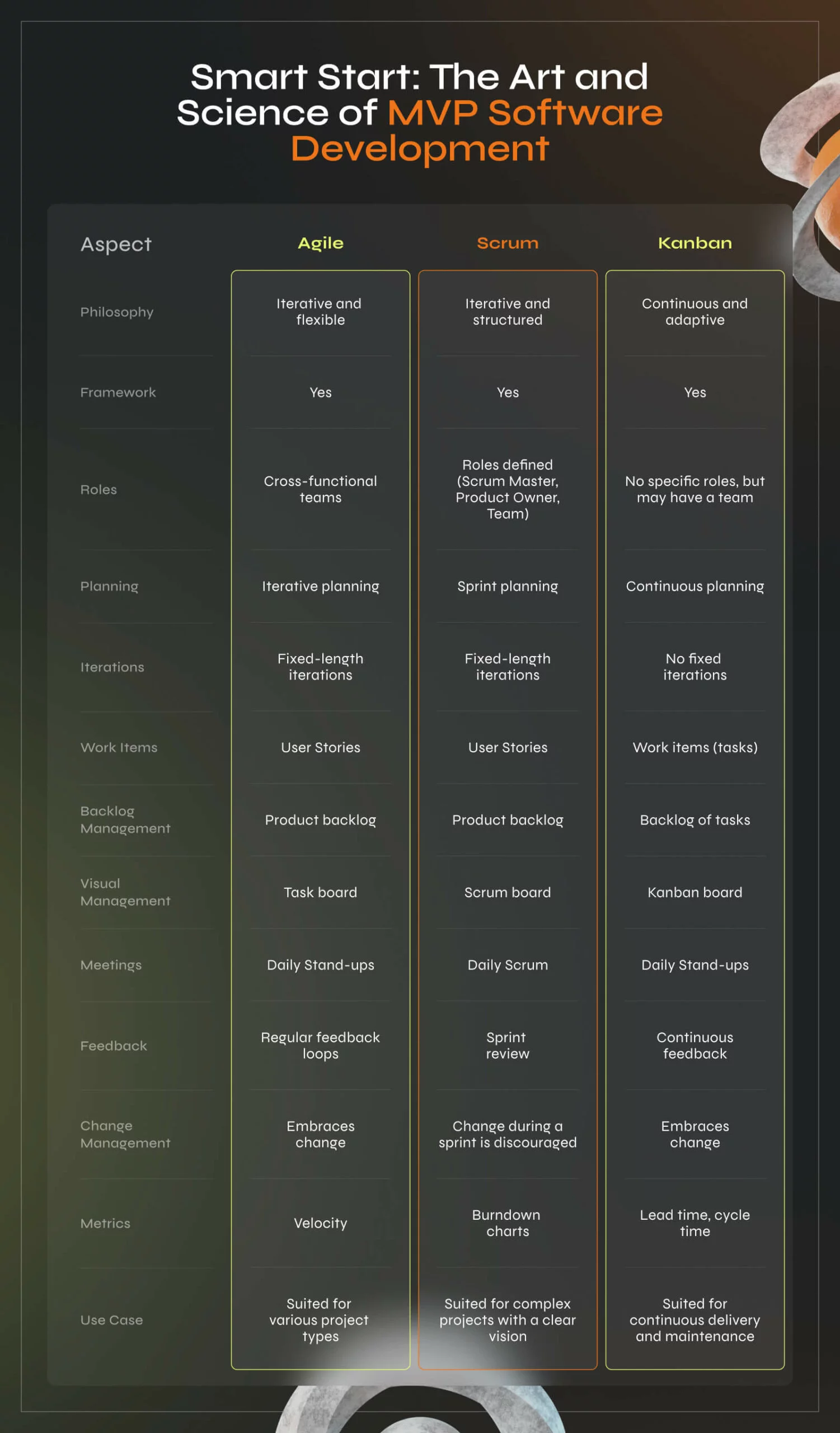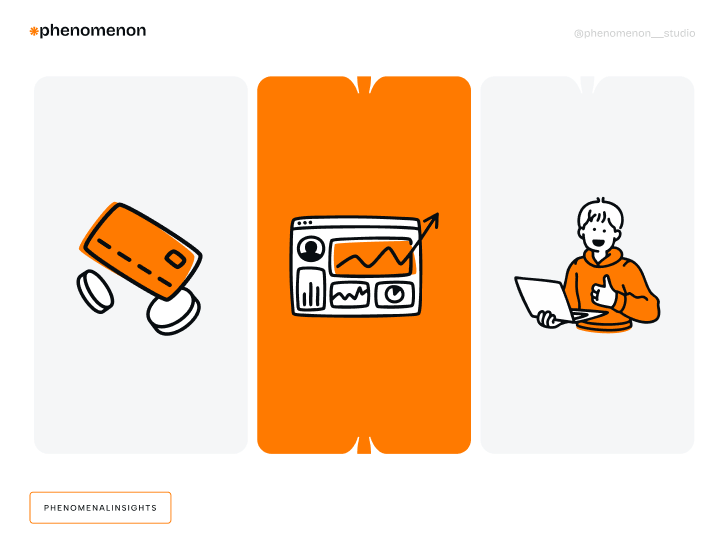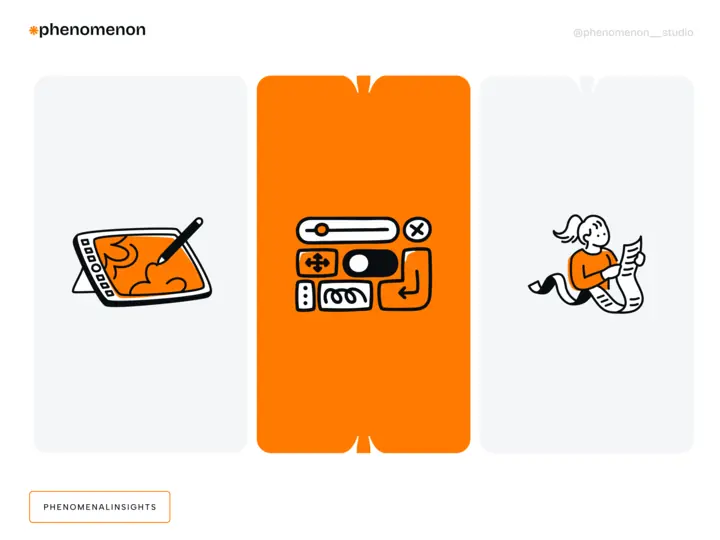Dive into the essentials of MVP software development with our detailed guide. Discover the art and science behind successful MVPs, from ideation to launch, and learn how to create a product that perfectly aligns with market needs.
Your product’s success directly results from the right market fit and meticulous testing after the development stage. A minimal viable product, or an MVP, ensures you have a fully workable solution that has already started introducing value to your target audience, but only with core functionality. At Phenomenon, we believe this approach is perfect for most startups that want to create a product that matters. Why? Because it’s impossible without taking your users’ opinions into account. Industry research reveals the bitter truth: 29% of startups run out of money before they become fully established. It happens because they bite off more than they can chew. MVP makes it impossible to hit a stumbling block. It sets you up for success.
Keep reading to learn more about what an MVP is in software development, and why it is the only viable option for startups with big aspirations.
MVP vs. PoC vs. Prototype
A Minimum Viable Product (MVP) is the initial version of a product. It includes only the essential features necessary to meet the needs of early users and gather feedback. The goal of an MVP is to provide users with a functional product quickly, validate assumptions, and learn from real-world usage. All these will help integrate extended functionality based on user feedback. This approach is crucial for informing future development.
A Proof of Concept (PoC) is a prototype or small-scale project. Its goal is to validate the technical feasibility or viability of a particular concept, technology, or methodology. It has to demonstrate that a certain idea or solution can be implemented successfully, often before committing to full-scale development. For example, a manufacturing company tests the feasibility of using blockchain technology for supply chain transparency. Using Ethereum and smart contracts, the PoC tracks product movement in a controlled environment, assessing performance and gathering feedback. The results help with implementation or coming up with an alternative approach.
A prototype is a preliminary model or version of a product, system, or component. It tests and showcases design, functionality, and user experience. Prototypes can be low-fidelity or high-fidelity representations, allowing stakeholders to visualize and interact with the product before full-scale development.
Low-fidelity prototypes are basic representations of a product, often created using simple digital mockups. They are cost-effective and quick to implement. On the contrary, high-fidelity prototypes are usually feature-rich, with more intricate designs and realistic content. The core difference between an MVP and a prototype is that the first is a working product for market testing, while the second is for usability and design testing.
Read also: Navigating the Benefits and Risks of Outsourcing App Development for App Owners
Design Thinking in MVP
At its core, design thinking is a human-centered approach that places empathy, ideation, and iteration at the forefront of the product development process. In the context of MVP software development, design thinking starts with a profound understanding of the end users and their needs. This empathetic exploration involves in-depth interviews, observations, and immersion in the users’ environment to uncover latent desires and pain points.
Prototyping, a key element of design thinking, comes into play as the ideas are transformed into tangible representations. Using tools like Figma or Adobe XD, designers create interactive prototypes that allow stakeholders to visualize and experience the proposed solution. In the case of an MVP for a collaborative project management platform, the prototype might showcase features such as real-time collaboration, task tracking, and intuitive user interfaces.
Continuous iteration is a hallmark of design thinking and is particularly valuable in the MVP phase. Based on user feedback gathered through prototype testing, teams refine and enhance the product iteratively. For example, if the MVP is a language-learning app, user feedback may reveal preferences for specific features, leading to iterative improvements in subsequent versions.
Technologies like rapid prototyping tools, user feedback platforms, and analytics play a vital role in facilitating the implementation of design thinking in MVP development. Through this approach, MVPs are not just minimal versions but strategic tools refined through empathy, creativity, and user-driven iteration, ensuring a more impactful and user-centric product.
Prioritizing Features
Choosing the right functionality is most important when building your first product. Here’s what you can do to ensure it works:
User-Centric Focus: Conduct user research to identify core user needs and pain points, informing the prioritization of features aligned with user expectations.
Define Core Value Proposition: Clearly articulate the unique value your product offers, identifying features directly contributing to the core functionality that distinguishes your product in the market.
Prioritization Criteria: Establish criteria for prioritization, considering factors such as user impact, feasibility, and business value. Assign weights to features based on importance, technical complexity, and alignment with the overall product strategy.
Use Prioritization Techniques: Apply prioritization techniques, such as the MoSCoW method, Kano Model, and Impact-Effort Matrix, to categorize and evaluate features based on their impact, user satisfaction, and implementation effort.
Build a Roadmap: Develop a phased roadmap for feature implementation, organizing features into release phases while considering dependencies for a logical progression of functionality.
Iterative Planning: Embrace an iterative approach, regularly reviewing and updating feature prioritization as the project progresses and new insights emerge. Stay flexible for adjustments based on feedback and changing priorities.
Core functionalities for the MVP
Now, here’s the question: How do you determine which features are essential for your MVP, and which can wait? Objectively, the selection depends on the type of your product. For example, a healthcare app and an online retail store will be somewhat different in this regard. Now, since we’ve already mentioned these two projects, let’s consider them in greater detail.
In an MVP for a healthcare app, user authentication and onboarding take on a crucial role due to the sensitive nature of health information. The focus would be on implementing a secure authentication system and streamlining the onboarding process, collecting essential medical history and user details to create health profiles. Key features in the healthcare app’s MVP might include functionalities like symptom tracking, medication reminders, and telehealth consultations, providing immediate value to users by addressing their health management needs.
The search function and navigation would be tailored to facilitate easy access to health information, nearby clinics, and specialists. Data input and output functionalities would revolve around empowering users to input health data, such as symptoms and vital signs, with clear outputs offering personalized health recommendations based on the inputted data. Additionally, communication features could include secure messaging for users and healthcare professionals, fostering a collaborative and supportive environment.
On the other hand, in an online retail store’s MVP, user authentication is less critical but still preferred for a smooth shopping experience. The emphasis would be on creating and managing user profiles, allowing customers to track their orders and preferences. Key features might include a product catalog, a shopping cart, and a simplified checkout process. Search and navigation functionalities would prioritize user-friendly browsing, ensuring customers can quickly find products of interest. Communication features could include order status updates and customer support inquiries.

Agile, Scrum, and Kanban methodologies
First, let’s talk about Agile. Agile is a flexible and iterative approach to software development that prioritizes collaboration, adaptability, and customer feedback. It involves breaking down a project into smaller increments, allowing continuous delivery and improvement. Agile emphasizes cross-functional teams, regular client involvement, and the ability to respond to changing requirements throughout development. It is suitable for most types of MVP projects, especially those where requirements may evolve or change based on user feedback. Agile facilitates continuous adaptation and delivery, making it well-suited for exploratory projects.
Scrum, on the other hand, is a framework that provides a structured yet flexible approach to product development. It divides work into fixed-length iterations called sprints, usually lasting two to four weeks. Scrum includes defined roles (such as Scrum Master and Product Owner), ceremonies (like sprint planning and daily stand-ups), and artifacts (such as the product backlog and sprint backlog) to facilitate efficient collaboration and communication within cross-functional teams. Scrum is perfect for MVP projects with a fixed timeframe and well-defined goals. Scrum’s structured approach is beneficial when there is a clear understanding of project requirements and a need for regular, fixed-length planning cycles.
Kanban is a methodology that visualizes work as it progresses through a process, typically using a Kanban board. It focuses on continuous delivery and emphasizes limiting work in progress (WIP) to optimize efficiency. Kanban provides flexibility in workflow management, allowing teams to adapt to changing priorities and allocate resources based on real-time demand. Kanban works best for MVP projects with fluid requirements or evolving priorities. Kanban’s flexibility and emphasis on continuous delivery make it suitable for projects where work items may change dynamically, and there is a need for constant adaptation.

Lean Startup Principles (Build-Measure-Learn Cycle)
The Build-Measure-Learn cycle, a central tenet of the Lean Startup methodology, comprises three sequential steps, each integral to the iterative product development process. The initial “Build” phase focuses on crafting a Minimum Viable Product (MVP) — a streamlined version designed to test and validate core hypotheses. This involves identifying essential features, prioritizing them, and swiftly developing the MVP for rapid market entry.
Following the “Build” phase, the cycle proceeds to “Measure,” where the emphasis shifts to data collection and analysis. This involves implementing analytics tools to track user engagement, behavior, and other relevant metrics. Key performance indicators (KPIs) are defined and measured to gain quantitative insights into how users interact with the MVP.
The final stage, “Learn,” synthesizes the data gathered in the previous steps to inform subsequent iterations. This step involves a comprehensive analysis of user feedback and performance metrics, allowing the development team to draw meaningful conclusions. The insights gained guide decision-making, enabling the team to refine and adjust the product based on empirical evidence and real-world user experiences.
Overall, the Build-Measure-Learn cycle encapsulates a continuous and adaptive approach to product development, fostering innovation and responsiveness to market dynamics.

Benefits of MVP Development
Values like faster time to market and user validation are too obvious to pay much attention to. Instead, let’s look beyond the surface. What truly makes MVP worth your attention? Why should MVP be the first-priority choice for startups?
Refined Product Roadmap
The iterative nature of MVP development enables teams to adjust and refine their product roadmap based on real-world user experiences. This adaptability helps prioritize features that align more closely with user needs and market demands. As a result, you get a more targeted and effective product strategy.
Early Community Building
Launching an MVP creates an opportunity for businesses to start building a community around their product early in the development cycle. Engaging with early adopters fosters a sense of ownership and loyalty, setting the foundation for a supportive user community as the product evolves.
Reduced Development Risks
MVP development allows for the identification and mitigation of potential risks early in the process. By addressing challenges and refining the product iteratively, businesses can minimize the likelihood of major setbacks during later stages of development, resulting in a more stable and resilient product.
Agile Problem Solving
MVP development cultivates an agile problem-solving mindset within the development team. The iterative feedback loop encourages teams to respond quickly to challenges, experiment with solutions, and make data-driven adjustments, fostering a culture of continuous improvement and innovation.
Informed Scalability Decisions
The insights gained from the MVP phase inform decisions related to scalability. Businesses can assess user demand, infrastructure requirements, and potential challenges, allowing for more informed and effective scaling strategies as the product gains traction.
Enhanced Customer Understanding
Beyond basic user feedback, MVP development provides deeper insights into customer behavior and preferences. Understanding how users engage with the product in real-world scenarios helps businesses tailor their offerings to meet specific customer needs, resulting in a more customer-centric product.
Iterative Brand Building
Launching an MVP enables businesses to begin shaping their brand identity and perception early on. Iterative releases allow for a gradual and deliberate approach to brand building, aligning the brand with user expectations and feedback over time.
Challenges and Solutions
One common hurdle of MVP is the absence of a well-defined product vision or ambiguous goals. It can lead to challenges in prioritizing features and setting a clear direction for development. One option, in this case, is to define the MVP’s goals, conducting workshops, stakeholder meetings, and market research. This will ensure each member of the development team has a clear vision of what to do.
Another challenge is the risk of feature overload. In this case, the bare essentials morph into an unnecessary surplus. Too many features lead to extended deadlines and greater expenditures. The solution lies in meticulous prioritization, focusing on features that directly impact the core value proposition.
Insufficient user feedback is a persistent challenge that can hinder the effectiveness of MVP development. Limited user input may result in a product that falls short of meeting user needs or expectations. However, this issue can be easily addressed by implementing robust feedback mechanisms such as user surveys, beta testing, and analytics tools. Encouraging early user engagement establishes a continuous feedback loop, allowing for iterative improvements.
Another common challenge is technical debt accrued through the rapid development pace inherent in MVP projects, which can have repercussions on the scalability and maintainability of the product in the long run. Striking a balance between speed and quality is crucial. Addressing critical technical debt early in the development process ensures the foundation of the product remains robust, supporting future iterations and scaling efforts.
Final Thoughts About MVP in Software Development
MVP is an excellent way of transforming your idea into a reality. We believe this method is a safe way to validate that people find your product as useful as you do.
Much more can be said about MVP, especially if you’ve already decided to take this path. But in order to make our advice helpful and project-specific, it’s important to consult with our team. Our experts will be happy to advise you on the details of your project, taking into account your industry, budget, and preferences.













